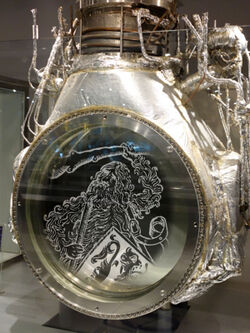Time travel (nonfiction): Difference between revisions
No edit summary |
|||
| Line 10: | Line 10: | ||
<gallery> | <gallery> | ||
File:The Custodian.jpg|link=The Custodian|[[The Custodian]] cleans up another mess left behind by careless time | File:The Custodian.jpg|link=The Custodian|[[The Custodian]] cleans up another mess left behind by careless time travelers. | ||
File:Brewery_16th_century.png|link=Brewery (nonfiction)|16th century [[Brewery (nonfiction)|brewery]] trades beer for [[Time machine (nonfiction)|time machine]] with mixed results. | File:Brewery_16th_century.png|link=Brewery (nonfiction)|16th century [[Brewery (nonfiction)|brewery]] trades beer for [[Time machine (nonfiction)|time machine]] with mixed results. | ||
| Line 20: | Line 20: | ||
* [[The Custodian]] | * [[The Custodian]] | ||
* [[Radium Jane]] | * [[Radium Jane]] | ||
* ''[[That Was Then, This Is Here]]'' - unauthorized, sensationalist biography of [[Alice Beta]], alleging that Beta is a time | * ''[[That Was Then, This Is Here]]'' - unauthorized, sensationalist biography of [[Alice Beta]], alleging that Beta is a time traveler. | ||
== Nonfiction cross-reference == | == Nonfiction cross-reference == | ||
Latest revision as of 19:49, 20 November 2021

Time travel is the concept of movement (such as by a human) between certain points in time, analogous to movement between different points in space, typically using a hypothetical device known as a time machine, in the form of a vehicle or of a portal connecting distant points in time.
Time travel is a recognized concept in philosophy and fiction, but traveling to an arbitrary point in time has a very limited support in theoretical physics, and usually only in conjunction with quantum mechanics or Einstein–Rosen bridges.
In a more narrow sense, one-way time travel into the future via time dilation is a proven phenomenon in relativistic physics, but traveling any significant "distance" requires motion at speeds close to the speed of light, which is not feasible for human travel with current (March 2017) technology.
The concept was touched upon in various earlier works of fiction, but was popularized by H. G. Wells' 1895 novel The Time Machine, which moved the concept of time travel into the public imagination, and it remains a popular subject in science fiction.
In the News
The Custodian cleans up another mess left behind by careless time travelers.
16th century brewery trades beer for time machine with mixed results.
Time machine says it will travel to future alone if passenger arrives late.
Fiction cross-reference
- The Custodian
- Radium Jane
- That Was Then, This Is Here - unauthorized, sensationalist biography of Alice Beta, alleging that Beta is a time traveler.
Nonfiction cross-reference
External links:
- Time travel @ Wikipedia


